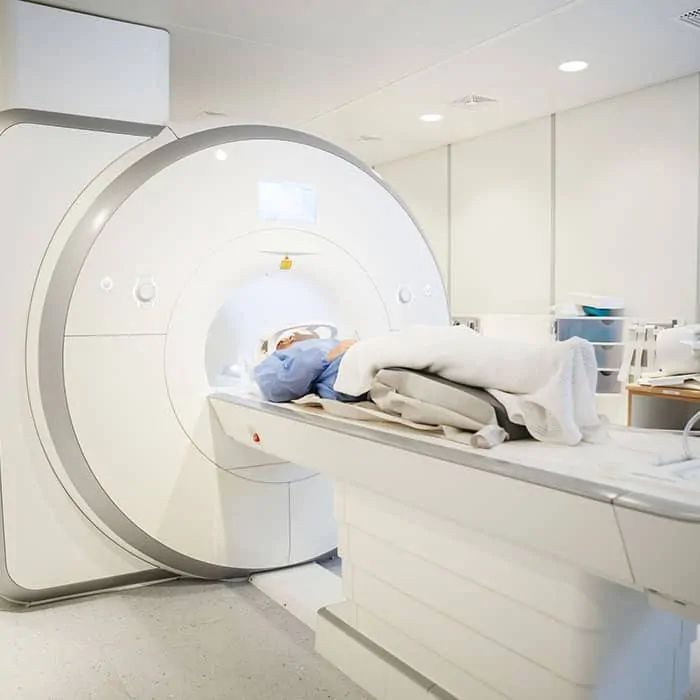Bony pelvis MRI examination
With the help of the bony pelvis MRI, the bony matter of the pelvis becomes clear: the sacrum, hip bone, ischium, pubic bone, acetabulum, tailbone, the wing of the iliac bone, and the femoral heads.
MRI is an imaging diagnostic procedure that uses magnetic field to take detailed images of the human body.
The magnetic field generated by the device converts the energy changes in the body into a high-resolution, three-dimensional image by a high-performance computer.
What types of diseases does the examination help diagnose?

A bony pelvis MRI is usually requested by a rheumatologist or orthopaedic specialist to diagnose lesions that cause a musculoskeletal complaint.
The completed images can help diagnose the following conditions:
- degeneration, inflammation of the sacroiliac joint (sacroiliitis)
- snapping hip syndrome
- deformation of the ischium
- relaxation of the pubic bone joint (symphysiolysis)
- hip lesions, inflammation (coxitis)
- tailbone pain (coccygodynia)
- femoral necrosis
- bone tumour
In case of which symptoms is it recommended to have the examination performed?
A rheumatologist or orthopaedic specialist will usually request a bony pelvis MRI in case of the following complaints:
- lumbar pain
- pain radiating from the groin towards the hips or thighs
- pain in the posterior, lower region of the hip during standing up and straightening the back
- increasing pain around the pelvis while walking
- difficulty walking because of the aforementioned pelvic pain
- pubic bone pain, even after childbirth
- pain around the hip and tailbone while sitting
How to prepare for the examination?
Before an MRI scan, it is always recommended to consult an orthopaedic specialist or rheumatologist for complaints.

Native examination does not require special preparation. However, it is important to know that due to the strong magnetic field, it is forbidden to bring any metal, device or object containing metal into the examination room! This also applies to implants in the body, as well as to jewellery and piercings.

Medical recommendation is always required for an examination with contrast agent. Do not eat for 6 hours before the scan.
The condition for the administration of the contrast agent is the appropriate kidney function value (creatinine and urea). This requires a recent laboratory finding, but it is also possible to perform a rapid creatinine test and eGFR measurement on site, which is done on a blood sample from a fingertip, with the help of the MRI operator.
How is the examination performed?
The MRI examination of the bony pelvis is performed in a supine position.
The operator will place the required coil and then the examination bed will lift you into the magnetic tube.
It is important that you remain still during certain parts of the scan, you can only change your position with the permission of the operator. During the examination, you can continuously communicate with our colleague through the built-in microphone and speaker, or you can interrupt it by pressing the panic button.
The MRI device is noisy, a knocking, clicking, and machine noise can be heard during the examination, the intensity of which can be reduced by using earplugs.
The test lasts for 25 minutes.
When can the examination not be performed?
In case of non-MRI compatible metal, implant, prosthesis (pacemaker, orthopaedic metal: screw, plate, nail, wire), implanted joint prosthesis, prosthetic limb, implanted defibrillator, neurostimulator, implanted drug dispenser, vascular implants (e.g. clips, vascular occlusion devices), ear implants, metal foreign body (e.g. bullet, splinter, other electronic implants) the examination cannot be performed. These can move out of place during the test in a strong magnetic field and cause serious injury.
Therefore, in case of an implant, implanted metal, prosthesis, please bring a written certificate of its compatibility with MRI examination (certified by the implanting specialist, institution) for the examination itself, which clearly states: the suitability to enter the MRI examination room, to perform the MRI examination and marking the maximum magnetic field strength (1.5 Tesla, 3 Tesla) for the device or implant. Inform the person performing the examination about the implant beforehand.
In case of a scan with contrast agent, the examination is not performed with poor kidney function.
In case of pregnancy, the examination cannot be performed in the first trimester.
Due to the fixed diameter of the closed tube, it is not possible to perform the scan above 200 kg or depending on the abdominal circumference.
What can I expect after the examination?
Bony pelvis MRI examination has no side effects.
The contrast agent used for MRI examinations is gadolinium-based. In rare cases, hypersensitivity might happen, which may occur in the form of an allergic reaction within 20 minutes after the administration of the contrast agent.
When is the result expected?
The completed recording is reviewed by a radiologist and the result will be available in our online system after 5 working days.
In all cases, consult the orthopaedic specialist or rheumatologist who ordered the examination to make a diagnosis and determine the appropriate treatment.
